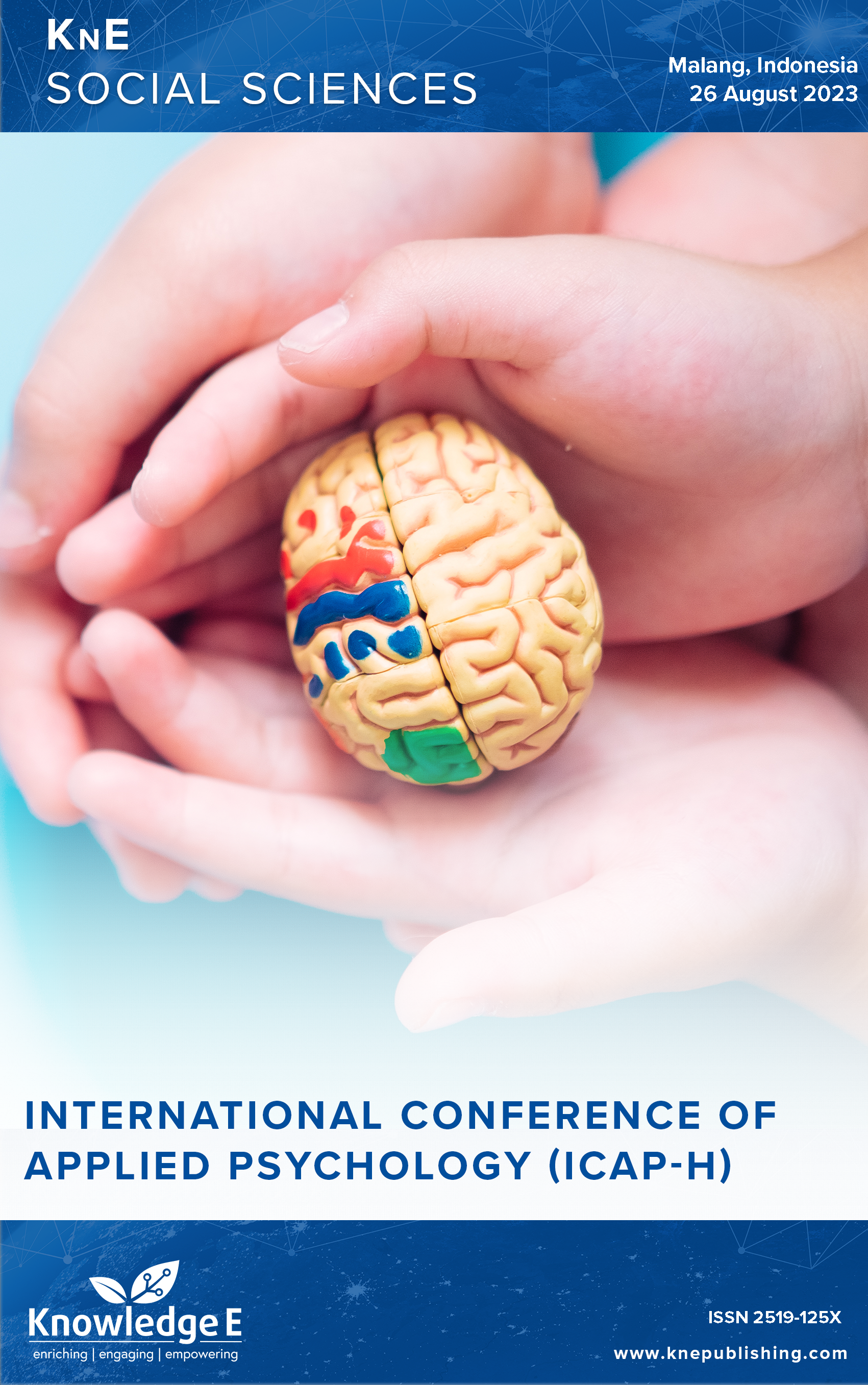Prompting-fading with Visual, Auditory, Kinesthetic, Tactile (VAKT) Media for Reading Skills of Dyslexia Children
DOI:
https://doi.org/10.18502/kss.v9i5.15171Abstract
Dyslexia children have problems with recognition, data accuracy, poor decoding, and poor spelling skills. Of course they need appropriate learning or implement the advantages they have. There are several intervention methods that can overcome the learning difficulties of children with dyslexia, one of which is using multisensory (VAKT). This VAKT method maximizes the implement of the senses in its intervention. The implementation of VAKT can be collaborated with prompting-fading in dyslexic children. The purpose of this study was to determine whether the prompting-fading technique with VAKT media could improve early reading skills in dyslexic children in elementary school. This study uses a quantitative approach with a single-case experimental design. The instrument used in this study refers to the Early Grade Reading Assessment (EGRA). The results showed an increase in the initial reading ability score in dyslexic children. It can be concluded that the prompting-fading technique with VAKT media is able to improve the early reading ability of dyslexia children.
Keywords: early reading ability, dyslexia, prompting-fading, VAKT media
References
Susanto E, Nugraheni AS. Metode VAKTS solusi untuk kesulitan belajar membaca permulaan pada anak hiperaktif. Muallimuna J Madrasah Ibtidaiyah. 2020;6:9–16. https://doi.org/http://dx.doi.org/10.31602/muallimuna.v6i1.2506 DOI: https://doi.org/10.31602/muallimuna.v6i1.2506
Santrock JW. Educational psychology. New York: Publishing, McGraw-Hill Medical; 2007.
Chall JS, Jacobs V, Baldwin L. The reading crisis: Why poor children fall behind. Cambridge: Harvard University Press; 1990. DOI: https://doi.org/10.4159/9780674029354
PISA. Student performance 2018. https://www.oecd.org/pisa/PISA 2018 Insights and Interpretations FINAL PDF.pdf
Hidayah N, Novita. Peningkatkan kemampuan membaca permulaan dengan menggunakan metode struktur analitik sintetik (SAS) mata pelajaran bahasa indonesia pada peserta didik kelas II C semester II di MIN 6 Bandar Lampung T.A. 2015/2016. Jurnal Pendidikan dan Pembelajaran Dasar. 2016;3:85–102.
Dewi SUS. Pengaruh metode multisensori dalam meningkatkan kemampuan membaca permulaan pada anak taman kanak - kanak. J Progr Stud PGMI. 2015;2:1– 13.
Muammar. Beginning reading in elementary school. Sanabil; 2002.
Pratiwi HR. Penerapan permainan kabar (kata dan gambar) untuk meningkatkan keterampilan membaca pemahaman teks dongeng di kelas III SDN Mandalaherang III Kecamatan Cimalaka Kabupaten Sumedang. Univesitas Pendidikan Indonesia, 2015.
E W, J. M. Dyslexia: detection, diagnosis, treatment at school and home. Yogyakarta: Prenada Media; 2017.
American Pyschiatric Association. Diagnostic and statistical manual of mental disorders. 2013. https://doi.org/10.1016/B0-12-657410-3/00457-8. DOI: https://doi.org/10.1176/appi.books.9780890425596
Santrock JW. Child development. Jakarta: Erlangga; 2011.
Hurlock BE. Psikologi perkembangan. Jakarta: Erlangga; 2019.
Rose TE, Zirkel P. Orton-Gillingham methodology for students with reading disabilities 30 years of case law. Journal of Special Education. 2007;41:171–185. https://doi.org/10.1177/00224669070410030301 DOI: https://doi.org/10.1177/00224669070410030301
Martin G, Pear J. Behavior modification:What it is and how to do it. 11th ed. 2019. DOI: https://doi.org/10.4324/9780429020599
Morris D, Bloodgood JW, Lomax RG, Perney J. Developmental steps in learning to read: A longitudinal study in kindergarten and first grade. Reading Research Quarterly. 2003;38:302–328. https://doi.org/10.1598/rrq.38.3.1 DOI: https://doi.org/10.1598/RRQ.38.3.1
Miltenberger RG. Behavior modification: Principles and procedures. 6??h ed. Cengage Learn; 2016. p. 690.
Cengher M, Budd A, Farrell N, Fienup DM. A review of prompt-fading procedures: Implications for effective and efficient skill acquisition. Journal of Developmental and Physical Disabilities. 2018;30:155–173. https://doi.org/10.1007/s10882-017-9575-8 DOI: https://doi.org/10.1007/s10882-017-9575-8
Eren B. Music and dyslexia: The therapeutic use of instrument (piano) training with a child with dyslexia (A case study). Journal of Education and Practice. 2017;8:97–108.
Parmawati SB, Prasetyawati W, Prianto RMA. Efektivitas pendekatan modifikasi perilaku dengan teknik fading dan token economy dalam meningkatkan kosakata siswa tuna rungu prelingual profound. Psibernetika. 2015;8:1–10.
Nagler T, Korinth SP, Linkersdörfer J, Lonnemann J, Rump B, Hasselhorn M, et al. Textfading based training leads to transfer effects on children’s sentence reading fluency. Frontiers in Psychology. 2015;6:1–8. https://doi.org/10.3389/fpsyg.2015.00119 DOI: https://doi.org/10.3389/fpsyg.2015.00119
Komalasari MD. Metode multisensori untuk meningkatkan kemampuan membaca pada peserta didik disleksia di sekolah dasar. J. Proseding Semin. Nas. PGSD UPY. 2015, 97–110 p.
Ritchey KD, Goeke JL. Orton-Gillingham and Orton-Gillingham-based reading instruction: A review of the literature. Journal of Special Education. 2006;40:171– 183. https://doi.org/10.1177/00224669060400030501 DOI: https://doi.org/10.1177/00224669060400030501
Prasetyaningrum S, Faradila A. Application of VAKT methods (visual, auditory, kinestetic, and tactile) to improve the ability reading for mild mental retardation. Proceedings of the 4th ASEAN Conference on Psychology, Counselling, and Humanities (ACPCH 2018). 2019;304:379–85. https://doi.org/10.2991/acpch-18.2019.91 DOI: https://doi.org/10.2991/acpch-18.2019.91
Maulana S, Sumekar G, Iswari M. Efektivitas metode VAKT untuk meningkatkan kemampuan menulis permulaan bagi anak kesulitan belajar. J Ilm Pendidik Khusus. 2013;2:222–233.
Purnamasari P, Soendari T. Metode VAKT untuk pembelajaran membaca permulaan anak tunagrahita ringan. J Asesmen Dan Interv Anak Berkebutuhan Khusus. 2018;19:25–31.
Sari RP, Suryani NA, Imran RF. Peningkatan kemampuan membaca permulaan dengan menggunakan metode bermain flash card subaca. Al-Athfaal J Ilm Pendidik Anak Usia Dini. 2018;1:36–55. https://doi.org/10.24042/ajipaud.v1i2.3741 DOI: https://doi.org/10.24042/ajipaud.v1i2.3741
Rizkiana. Analisis kesulitan membaca permulaan siswa kelas 1 SDN Bangunrejo 2 Yogyakarta. J Pendidik Guru Sekol Dasar. 2016:346.
TR. K. Single subject research: Strategies for evaluating change. Cambridge: Academic Press; 2015.
Bobrovitz CD, Ottenbacher KJ. Comparison of visual inspection and statistical analysis of single-subject data in rehabilitation research. American Journal of Physical Medicine & Rehabilitation. 1998;77:94–102. https://doi.org/10.1097/00002060- 199803000-00002 DOI: https://doi.org/10.1097/00002060-199803000-00002
Anggara B. Kunci mendidik dan mengasuh anak disleksia. Yogyakarta: Relasi Inti Media Group; 2015.
Robinson HM. Factors which affect success in reading. Elementary School Journal. 1955;55:263–269. https://doi.org/10.1086/458682 DOI: https://doi.org/10.1086/458682
Gohar R. The effect of multisensory structured EFL program on developing primary pupil’s phonological awareness and spelling. Education Sciences, 2019;27:1–35.
Jeyasekaran J. Effectiveness of visual auditory kinesthetic tactile technique on reading level among children with dyslexia at Helikx Open School and LearningCentre, Salem. International Journal of Medical Science and Public Health. 2015;4:315. https://doi.org/10.5455/ijmsph.2015.0511201467 DOI: https://doi.org/10.5455/ijmsph.2015.0511201467
Mathias B, Klingebiel A, Hartwigsen G, Sureth L, Macedonia M, Mayer K, et al. Sensorimotor cortices casually contribute to auditory foreign language vocabulary translation following multisensory learning. Brain Stimulation. 2019;12:401–402. https://doi.org/10.1016/j.brs.2018.12.295 DOI: https://doi.org/10.1016/j.brs.2018.12.295
Sayeski KL, Earle GA, Davis R, Calamari J. Orton Gillingham: Who, what, and how. Teaching Exceptional Children. 2019;51:240–249. https://doi.org/10.1177/0040059918816996 DOI: https://doi.org/10.1177/0040059918816996
Suggate S, Pufke E, Stoeger H. Do fine motor skills contribute to early reading development? Journal of Research in Reading. 2018;41:1–19. https://doi.org/10.1111/1467- 9817.12081 DOI: https://doi.org/10.1111/1467-9817.12081

